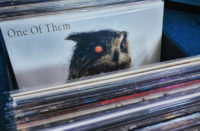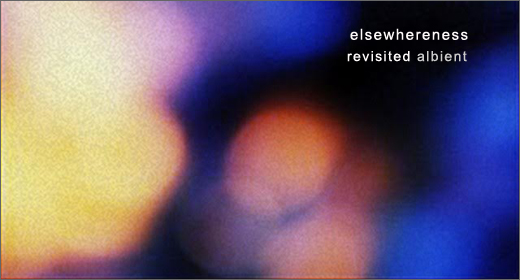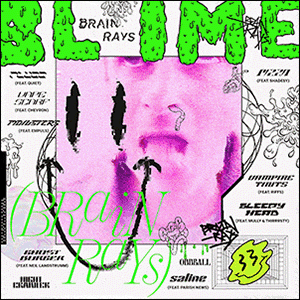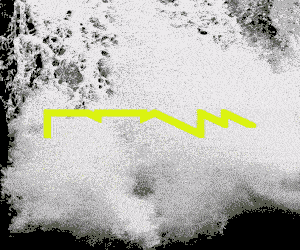Elsewhereness revisited is an occasional feature documenting the drift at the margins: ambient gasbagging, ’tube-d, ’cloud-ed, and ’camped-up, complete with companion mix, Elsewhereness revisited #3
1991 made waves in 2012 with High-Tech High-Life (Opal Tapes)—chewy New Age synth ‘n’ soundscapes laced with arpeggiating timbres and shimmering drones, and self-titled (Astro:Dynamics)–IDM-y sounds shot through with post-ambient forms and off-kilter melodies, while his Skogen, Flickan Och Flaskan was also a highlight of OT’s unkempt catalog. Four years on, Axel Backman revisits 1991, and No More Dreams‘s gauzy dreamscapes prove similarly compelling; from “1” with its sparse mechanical sequences through to bleaker terrain as it goes, ending in ascent into a void of post-isolationist ambient kinesis, ‘perfectly capturing the blissful space between The Skaters Wind Drapeing Incense, the long haul flight sedation of Huerco S. and the crunchy ambient techno fuzz of Shinichi Atobe.’ (bleep). 1991 channels 2016!
Signalling end-of-year’s approach, Kompakt chief, Wolfgang Voigt, again mixes oldies and newbies on the latest in the long-running series, Pop Ambient 2017: from the glacial-but-warm timbres of Jens-Uwe Beyer‘s atmoscapes, “Final 9.1” and “Final 10,” to the glitchy romanticism of Thore Pfeiffer‘s “Good Life;” from Leandro Fresco‘s beatific dronefests, “Sonido Español” and “El Abismo,” to Kenneth James Gibson‘s sulky epic, “Her Flood Knocked Me To The Ground (But I Was Already There).” Returners include Anton Kubikov and Cologne ranger, Max Würden, while Yui Onodera loses his PA cherry to faux-new age drone sculpture, “Cromo2,” and “Locus Solus,” with exp.-vet, Scanner. Voigt offers a Badalamentian rethink of “Hal” from Soulsavers’ Kubrick. Every one’s not a post-Enovian winner, but there’s more interesting than ignorable along the way.
Ohio exp/ambient label, Whited Sepulchre, launched earlier this year with Braeyden Jae‘s ‘morosely uplifting’ Fog Mirror, now hosts ant’lrd‘s Sleep Drive, a trio of cumulus-like aural drifts that ‘tackles the inherent physicality of arcing drones and bone-rattling low end.’ Colin Blanton is ‘lrd of the manna, melding melody, drone, and beat; the sometime curator of Chicago’s Baro, known for works by such as Benoît Pioulard and Odd Nosdam, got the latter to master, and Odd wrings melody from the ambient crackle wrapping the beats. Drone suite “MS-Dass” stretches across the B-side, a fine foil to the more roughshod rhythm of opener “Hood,” a lumbering trudge-hop affair of gruzzy synth-fuzz, while the more elusive “Kasuisai”–whose video ‘follows a series of obscured but alluring images of nature, feeling not unlike a dosed walkabout or some pastoral waking dream’ (Ad Hoc)—plays out like some remote spirit kin of pastoral Kosmische synth-pioneers Cluster.
Latest from Harry Towell‘s Whitelabrecs is Come To The Surface from Colbets, previously on U-Cover, Twice Removed, Twisted Treeline, and vent. This Tokyo twosome—Saitoh Tomohiro, flying solo as Shreber Harber Mole Flying Wheel when not coupling with axe-scapeist, Kari Takemoto–traffic in dense hazily articulated drones. A ‘soundtrack to an imaginary nostalgic movie, designed to evoke thoughts of flickering, grainy film imagery’ premised on Enovian ambient principles, ground sound privileging neither fore- nor back-, while possessed of an affective freight drawing down into a nostalgic undertow. Masterfully mastered by Maps-man, Tim Diagram.
Seattle’s Further presents Muara, a debut from Seattle’s Monadh—tagged ‘an ambient album in the purest, chillest meaning of the term.’ Lest the vacuous c-word, and the array of aquatic signifiers and textures, each ‘a rejuvenating dip in healing, icy waters’ (Muara = “estuary” in Javanese) trigger a New Age alert, think ‘Biosphere. Loscil, and The Sight Below—musicians who uncannily make you warm to cold tones.’ Jake Muir calls it ‘slow improv,’ natural habitats also playing a major role, his favored music ‘informed by mood and place.’ Inspired by Andrew Pekler‘s Sentimental Favourites and Biosphere‘s Shenzhou, he infuses pitch-shifted pastoral and romantic samples with field sounds from the Pacific NW: “Ammophilia,” ‘a whirlpool of dark-blue drones with an undertow of poignant melody swirled into the mix,’ while “Calanque” ‘seems to be emerging from a fathomless cave, like a palliative gas, a calming ether.’ Mastering maestro, Rashad Becker, masters. Sound!
Still Further, John Daly’s ambient side-project, The Smoke Clears (see recent Five Questions), follows up debut album, Listen (2013), with a self-titled set that ‘builds upon its predecessor’s ambient abstractions while adding another layer of nuanced melodic contemplation.’ Hosting, Dublin’s All City dub it ‘lush downtempo machine music’ for home listening or bigger rigs. Building on its predecessor’s ambient abstractions, it adds another layer of nuanced melodic contemplation, as in “Fathoms,” which sets a deceptively calm tone, a sense of urgency developing till the dubbed out “Oh My Days” brings out his techno/house side, as heard on Running Back and One Track.
Michigan-based artist/producer Dominic Coppola‘s little number, Ladylike, sweetly spans 22 mins of smeary tonal drones that someone (here) says sets out ‘to paint an ambient mindscape of love restored.’ Oo-er. Dense, yet with aperture, the tracks spool out in an ebb-flow blur with a lo-fi widescreen gaze appeal, prompting a quick net-rummage that yielded a fuller portrait of Coppola as a young ambient drone man—cf. Opening night, Beloved, and Vogue Meditations. Note Swoon Season just landed aswespeak—all its title would indicate.
Latest in a flurry from Kane Ikin, Sensory Memory, a second addition to Echovolt‘s new experimental series, is ‘a well-rounded approximation of shoegazing techno,’ the kat reckons, ‘sounding out somewhere between the slow, heaving styles of Alessandro Cortini and Pye Corner Audio, with maybe a hint of HTRK’s narcotic sexiness for good measure.’ Ikin’s influences are ‘science fiction, broken synthesizers and endless horizons.’ Equal parts narcotic and kinetic, Sensory Memory explores Ikin’s formative genres and sounds, adding to ‘the unheimlich, anxious spaces’ of Modern Pressure (Type), igloo-‘viewed here, and more ‘floor-fuelled cousin, Basalt Crush (Latency).
Old favourite, Hakobune, creator of immersive harmonized dronescapes, is back (was he ever away?), mixing light-dark, cool-warm, opaque-translucent, intro-/extro-spection. Moraine (a surface accumulation of soil and rock left when glaciers melt and recede, forming dramatic, desolate, vistas) for Adhesive Sounds, finds him at his most expansive, lending a sense of still and rugged beauty with nebulous sequences of guitar deployed to transportive effect. Stopping only to unload Impalpable Ashes for Ghost Organics, he welcomes his chum Chihei, who plugs into Taka’s stack to knock off The fall rises, waxing ‘drone sounds of two guitarists produces a wave of excellent overtones. this album has hidden harmony with depth and poetic story such as the symbolic and abstract. tone colors of Stratocaster and Les Paul reverberate slowly with chord like Slowdive and My Bloody Valentine. It seems inscribe eternal time. this album is recorded three songs with a sadness and beauty, such as feel the coming of fall. Infinite and fantastic sounds attract lisner to meditative position.’ Inimitable.
Tape Loop Orchestra is back with an album of stratified slowcore micro-symphonics following up GSTTLOATYL and In A Lonely Place. For The Invisibles Andrew Hargreaves takes on the Great Beyond with a widescreen approach incl. parapsychological studies of EVP, Sun Ra’s cosmic noise noumena, a mystery anonymous book “The Invisibles,” and the work of Dutch conceptual artist Bas Jan Ader, whose final incomplete work involved a failed, solo transatlantic crossing in a small boat—found, without its captain, 150 miles from the Irish coast. ‘A vast sound intended to dilate the listener’s consciousness; conflating notions of high and low brow art to open a space for intuitive reception and perception’ (boom!) TLO’s strings and voice swell-relent with a richer richness of texture and deeper depth of field than ever.
Previously on igloo, Drape‘s An Idea and Its Map was tagged as ‘neither New Age lull-fest nor doomy drone–sprawl, spooling sonorous squalls and tender timbres from drone-base to bliss-out, and on to post-classical soundtrack strains.’ Spencer Williams and Ryan Gracey had ‘thickened up their previous aethers into meatier micro-orchestrals and more caustic smears, charged with a particulate patina and a caché of dissolved grit.’ Now Let There Water Air, their second Infraction LP, ‘still maintains that sort of granular roughness, but the compositions feel more refined and emotionally exposed as they ebb and flow gracefully’ (igloo ‘view). You’ll find “New Mountains” rising up like a horizon-cresting sun, shrouded in guitar and cello haze and “Interiors” opening out with the remote buzz of a guitar and stark piano around which ambient air hangs like dust in light rays as the Portland pair’s sonic swoons spool out with micro-orchestral lightness and weight.
‘I think over the years, I’ve become more withdrawn. I don’t feel like anybody has anything to gain from peeking into my world,’ says Erik Kowalski in a recent interview, who, after reanimating Casino Versus Japan with Night On Tape (2010), went to ground again. While his (typically low) public profile went off the radar, he evidently continued sketching out ideas for tracks on his guitar and putting them aside for future use—which never came, and he ended up letting the tracks accumulate en masse on a hard drive. Over time as they started to pile up, he started messing around with sequencing them, and he ‘became aware of them existing on their own.’ Yikes!! Anyway, now Frozen Geometry has exited from its cryogenic state, layered and looped into immersive capsules of harmony and drift, 80 tracks clocking in at just over 3 hrs. Tape hiss makes you happy.
Kowalski’s Geometry turns out to be current listening matter of Benoît Pioulard (interview), whose The Benoît Pioulard Listening Matter comes out ten years on from debut, Précis (Kranky, 2006), seemingly marking a return to the ‘fragile beauty, heartfelt vocals, shimmering guitar textures, lo-fi production and sincere, beating heart’ of his early years. The Seattle-settled soundsmith has since pushed the envelope more compellingly into washed out axe’scapes, infused with field recordings and tape saturation, tapping into life’s fleeting moments and faded dreams. In some ways, his Listening Matter is a full-circle back to Precis, with its lo-fi folk-soaked vox-pop strum-fests, though there’s also a continuation of the luminous guitar-based loops and fields familiar from the likes of Sonnet and Noyaux, cf. “Ruth,” making for a crystallization of the elements in the Pioulard oeuvre. For those who prefer his swoon to his croon, there’s a third instalment of the drifting Stanza.
Which brings us to Sean Curtis Patrick, whose music under the alias Assembler/Responder is as worth your while as his video accompaniments for the aforementioned Benoît Pioulard, to say nothing of Alessandro Cortini (shshshh!). Patrick collects a quixotic quartet on his bc, released on his bd (32nd): The Apportioned Mass album and EPs Atlatl, Sweet Lake, Bitter Lake, and Interfax Ghosts, November bringing another, Meditations.
Before SCJ‘s video, a quick mention for young St. Petersburg sound artist, alineko, who dubs her summer of love ‘music to cuddle’—though whether it’s the music or someone else that’s object of the projected tactile affect is unclear. So-called Temple of Eternal Music, ΠANθEON, blurbs ‘Moments of sincerity under the summer sun. Reminiscences of the life, spent in the state of being right here and right now – simply experiencing the wholeness and interconnectedness of everything in the Universe. Aural continuum, that has no boundaries…,’ Zzzzz. Nice, though.
Bottle of Maggi seasoning, paperback of Kant’s Critique of Pure Reason, and a suitcase constitute Joseph Beuys‘ I Know No Weekend (1972). A prolific artist known for various Happenings such as whispering in the ear of a dead hare, a particular approach to materiality, and a belief in everyone’s capacity to be an artist, Beuys’ commonality with sound artist Yair Elazar Glotman, aka KETEV, is only tangentially evident. He has previous on Bristol’s Subtext, the link perhaps to Berlin and Portals Editions, which issues I Know No Weekend. Portents of something grim cede to glinting spacious sounds with a whirr of tape loop and percussive thrum set in nocturnal hum. “Stripes from the House of the Shaman” comes on like a benign experimental growth from Dino Sabatini‘s Shamans Paths, saturated with rich low-end tweaks of thunder and murk on “Lightning With Stag In Its Glare”. No great departure from a palette patented on works for Glacial Movements and Opal Tapes, but his incorporation of a wider spectrum of timbres and tones is at once haunting and hefty. Nooiiiice!
Sound Scavenger, Stuart Chalmers, has been active since 2007, repurposing old tapes from skips and thriftstores, blending decay, ambience, noise and improv to make ‘scapes enmired between consonance and dissonance. Obscure sounding object of desire, the Swarmandal, FX and tape tweaked, distinguishes The Heart of Wilderness (Was ist Das). Untitled, a split with fellow tape stalwart, Z. Zsigo (Cremation Lily), ‘favours a more active interaction with cassettes, building dense saturated worlds of anonymity and analog fog’ (Strange Rules). Apparently he’s to be seen live ‘pushing tapes into slots with the enthusiasm of an animated cartoon character, while wearing a really wonderful wig’ (Norman), a perfect accompaniment to In the Heart of Solitude (Constellation Tatsu), a set of artificially-assisted swarmandal improvs which ‘continues Chalmers loop fantasies with wonderfully plucked sounds that bump into and then off one another, each travelling while simultaneously being at home,’ (Norman), as he ‘blurs beauty and dissonance into some sort of distant star.’
Posh Isolationist Lars Hannes Norrvide, under the more technoid Norin alias, has a set of alienated romanticist electronics, Främmande, flirting with Abdulla Rashim and Varg‘s Northern Electronics, which enterprise hosts another quirky loner, Michel Isorinne, sometime half (Varg being his Other) of D.Å.R.F.D.H.S., for Echoic Memoir, playing out a nice mixture of Drone, Kosmische, and somewhat doleful ambience.
Russia’s Perfect Aesthetics hosts Måla for Carnal Sense, whose sensuous lo-fi ambient techno is unusual in having the amb and the tech genuinely enhance each other, with a carpeted 4-on-the-floor throb, cold-wavey synth-wash and veiled textures. Lush synthscapes evolve, part-dronebient backdrop, and revolve around the reverbed near-minimal punchy percussion between driving force and accompaniment, odd incisions from distorted vox samples and distant feedback. Bleak mixes with bliss, fleeting harshness with beauty. Carnal Sense manages to fuse these elements into something compelling. Kinky video alert!
https://youtu.be/ks_7SSgdwfA
Ambient drone trio, Triac, led by Rossano Polidoro, ex-Tu M’ (whose Monochromes Vol.1 (Line, 2009) was a beaut), purveys a highly processed strain of digital ambient: diaphanous drones in wispy harmonics. Bespoke post-digital label Line, typically associated with challenge, shows its amenability to the pleasures of a well-turned timbre—pleasingly present in Triac’s winsome Days (2015), and equally so Here. It shows Triac’s tone poetry ‘populating a maximally immersive sound space with minimal elements—primary forms, shadows and light, in constant mutation. […] recursive, not repetitious, pieces, phantom chamber loops in microsound motion.’ For Celer-y chewers, Basinski buffs and fans of ex-Tu M’ chum Emiliano Romanelli‘s Tabulatura.
Italy is home too to How To Cure Our Soul‘s Marco Marzuoli, whose Senza Titolo for Yann Novak‘s Dragon’s Eye is a single long-form improv drone work wrought from bass guitar, processed with analog and vintage instruments. It seeks to treat ‘the rediscovery of sound’s mortality and identity in an obscure and ethereal dimension, beyond time and space,’ Marzuoli’s ‘intimate low-fi catharsis’ affords a structure to ‘float in an occidental, nostalgic mantra,’ and ‘embrace both beauty and fragility of the flaws in minimalism.’ While we’re at it, his first solo outing, Appunti (Éter), a minimal piece for bass guitar, again reworked with analog and vintage instruments, aiming to be ‘the compositional report of five months of private notes,’ is a lowlight gem.
BLNDR‘s Drone Capacity (Natch) is a techno EP dressed in drone, the French producer’s tracks further tweaked by compatriot Hydrangea and Natch head, Synthek. Ritual ambient droner, “Temples and Mothership,” is principle object of interest here—though TOL adepts will warm to the atmospheric pressure and ‘floor-fill thrill of Synthek’s title track rework, as well as Hydrangea’s spatial organic tech-take on “Silent Quest.”
Intriguing emerging label, offworldcolonies ltd., releases Iris av is and more recently En värld av is by mysterious entity, Drottning Omma—amazing ambient/drone techno in true frigid form. & om det här är slutet är det vårt sista the Swedish imprint’s recent compilation, assembles offworldcolonies himself, [xxx], Pechblende, ıšdavıkaı, as well as the excellent Drottning Omma, and another new find, Cloistral, whose “Փրկություն” is a thing to behold, as is album, Նվիրվածություն, recorded live in Yerevan, Armenia.
https://youtu.be/o9n4wK0Cjfg
Paris’s Hylé Tapes hosts Oslo’s Anders Brørby with Mulholland Drive, 1984 for further dark ambient and abstract soundscapes in line with previous Nihil and the likes of fellow Nordic types, Helge Sten/Deathprod and Tim Hecker. Brørby traffics in processed field recordings, granular synth-works, loops and improvised laptop sessions, and reckons the album ‘works as the soundtrack for imaginary scenes and images taking place inside the listener’s head,’ inspired by the shadow world of David Lynch, with nods to Argento, Herzog, and Pasolini.
Samurai’s Sam KDC follows the blown out ambient aesthetic of KVLTVR with eschatological ambient epic, Cycles Of Perspective for ASC’s Auxiliary. Perhaps more in line with Late Night Innominate, Volume 1, it ranges from sombre to uplifting—brooding opener, “Inflow Cycle,” to ethereal closer, “Cycle Of Loss.” Via cosmically-inflected electro-acoustics and subtle electronics, Cycles‘ sometimes ambiguous ‘scapes find gravity-flouting floatpoint, seeking resolution towards a remote consonance rather than dissonance, musical or cognitive.
Body Boys achieve an odd juxtaposition of solemn neo-isolationist soundscapes with something more corporeal (hence the name?) on Insensate (Strange Rules); still life tinted with a gentle ebb and flow, in and out of sync with your blood pump. A cathartic introspection, internal solace found in the gently humming moments between tones, between breaths, between heartbeats (Tiny talk). Drones hang on whirring pulses for a sense of Mensch-Maschine.
Before signing off, a call to all appreciators of the marginal to update your L’eoscombu Couti collection with the ‘languid bliss-drone’ (Julian@LMYE) of la conduite d’un véhicule avec zéro émission à travers un paysage que vous vous souvenez depuis l’enfance I. Can’t wait for II.













